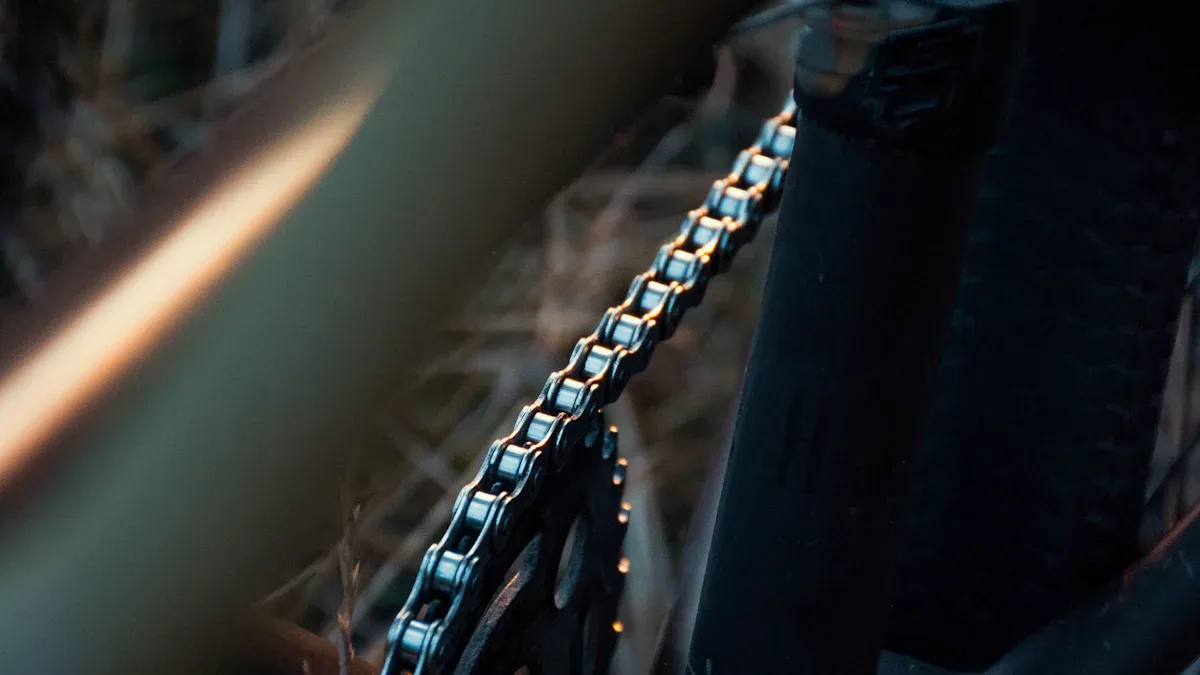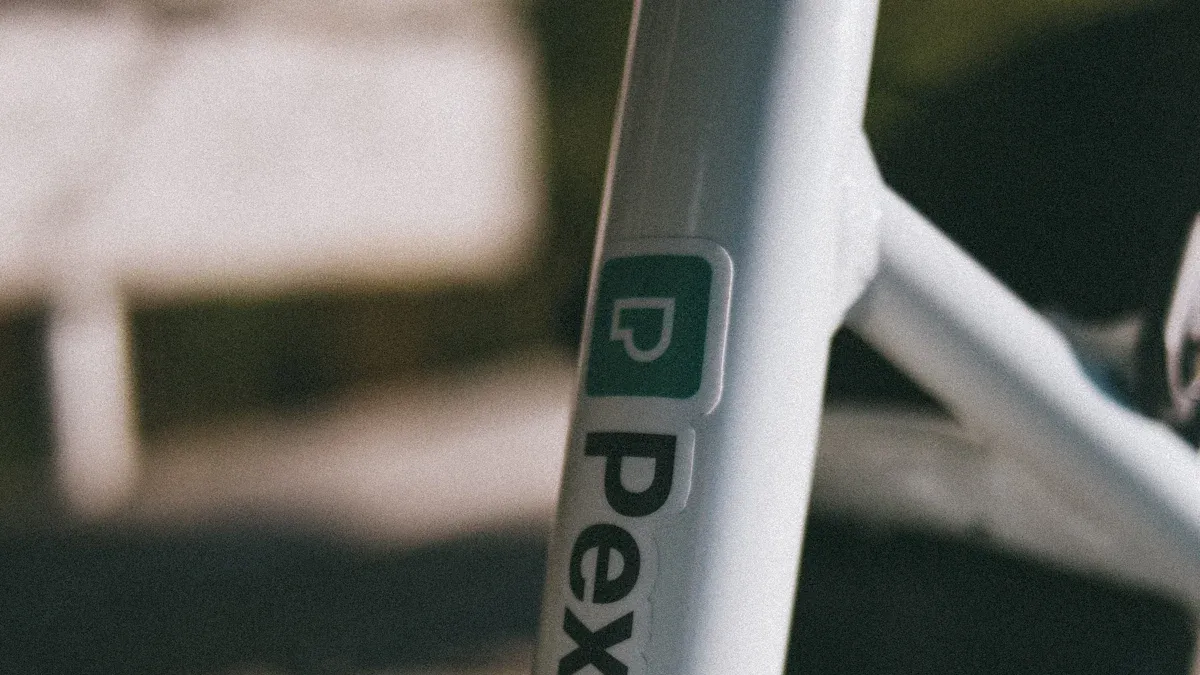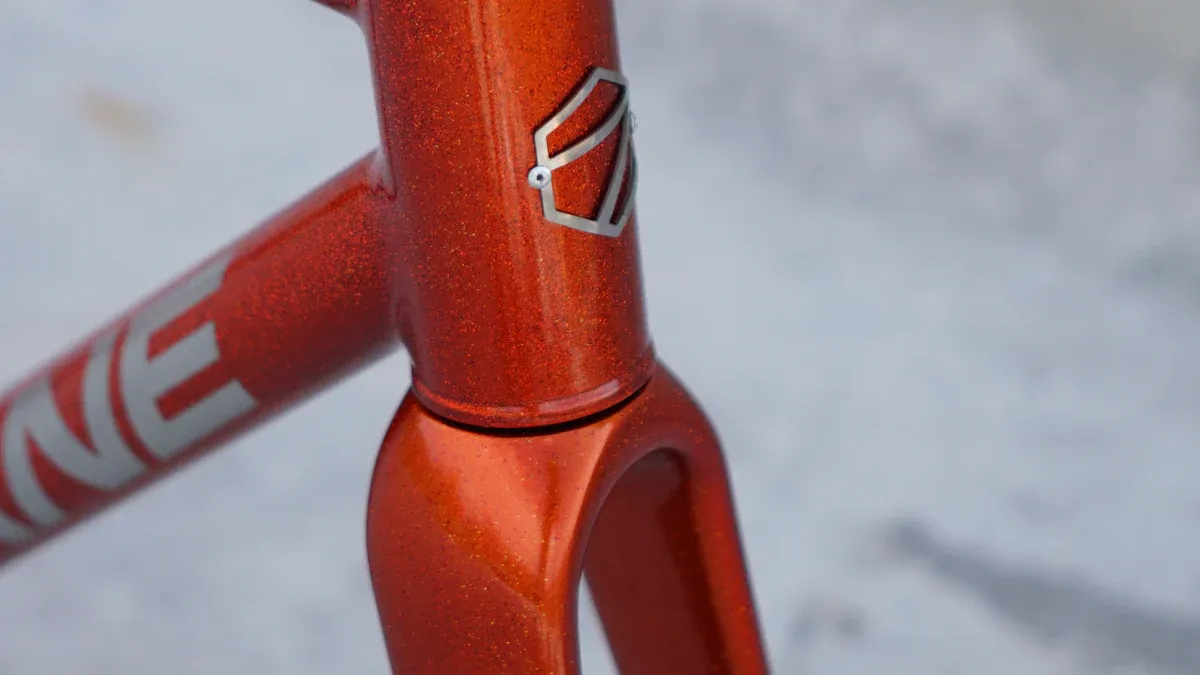
Knowing the mountain bike frame parts names is very important. It helps you ride better and take care of your bike. When you know the different parts, you can make smart choices about fixing and improving your bike. This knowledge helps you:
Check your bike often to stop damage.
Fix problems quickly to make your bike last longer.
By learning about these mountain bike frame parts names, you can enjoy riding more. You also help your bike last longer.
Key Takeaways
Knowing the parts of a mountain bike frame helps you ride better and take care of your bike.
The top tube affects how comfortable and in control you feel while riding. Its shape can change how you ride.
A strong down tube is very important for keeping your bike stable and safe, especially on bumpy trails.
Changing the seat tube height makes riding more comfortable and helps you pedal better, so your rides are more fun.
Chainstays and seatstays help keep the bike stable. Their length affects how well you handle different types of ground.
Top Tube

Function
The top tube is very important for your mountain bike frame. It connects the head tube in front to the seat tube in back. This connection gives the bike strength and stability. When you ride, the top tube helps spread your weight evenly. This affects how you sit and control the bike.
A good top tube design helps you stay comfortable while riding. If it is too long or too short, you may feel uncomfortable. You could lean too far forward or backward. This can make it hard to control the bike.
Design Variations
Different top tube designs can change how you ride. Here are some common features and their effects:
Design Feature | Effect on Rider Posture | Effect on Bike Handling |
|---|---|---|
Helps with aerodynamics, changing weight distribution | Affects stability and responsiveness | |
Aerobar Use | Supports strong body angles while keeping comfort | Changes handling characteristics |
The materials for the top tube also affect how the bike performs. Here’s a quick look at common materials:
Material | Pros | Cons |
|---|---|---|
Aluminum | Affordable, light, strong, and resists rust | Hard to fix, has a limited lifespan |
Carbon Fiber | Light, very stiff, and absorbs vibrations well | Costly, can break easily |
Steel | Strong, lasts long, and easy to repair | Heavier, can rust |
Titanium | Light, strong, and resists rust | Very costly, hard to work with |
New trends in mountain bike design show a move towards high-pivot suspension systems. These designs help the rear wheel move better when compressed, improving suspension. This change gives better stability, especially when going downhill. Also, high-rise handlebars help shift your weight back, improving control and comfort on trails.
When picking a bike, think about how the top tube design affects your riding style. Pro mountain bikers often check reach, head angle, and stack height to boost their performance. A longer reach can help with stability at high speeds, while a shorter reach makes tight turns easier.
Knowing how the top tube works and its design options can help you choose the right mountain bike frame. This knowledge makes your riding experience better and ensures you get a bike that fits your needs.
Down Tube

Strength Role
The down tube is very important for your mountain bike frame. It connects the head tube to the bottom bracket. This connection is key for the bike’s strength. A good down tube design stops bending and damage from hits. This is important for staying safe while riding.
When you think about frame materials, the thickness and shape of the down tube matter a lot. Thicker walls are needed to handle heavy loads during mountain biking. This design choice helps keep the frame strong under pressure. The right mix of strength, stiffness, and weight can make your ride much better.
Handling Impact
The down tube’s design also affects how your bike performs on bumpy trails. Here are some things to think about:
The head tube angle, rake, and trail change how the bike handles. This is important for staying stable on rough paths.
Bottom bracket height affects your center of gravity. This changes how the bike feels and works over bumps.
Chainstay length impacts how well your bike can turn and keep ride quality. This is key for getting through rough areas.
Common problems with down tube damage include bending from hits. This can put your safety at risk while riding. Repair options usually mean straightening the frame or replacing the tube by a builder. Many riders worry about riding with a damaged down tube. They fear it could cause more damage to the bike.
Knowing how important the down tube is helps you make smart choices when picking a mountain bike frame. A strong down tube makes your ride safer and more fun, especially on tough trails.
Seat Tube
Connection
The seat tube is very important. It connects the seat to the bike frame. It holds the saddle and lets you change its height and position. This connection is key for a comfy ride. A good seat tube design helps you sit better on the bike. This can improve how well you ride.
Here are some important things to think about for the seat tube:
Design Consideration | Implication |
|---|---|
Steep actual seat tube angle | Helps rider positioning |
Maximized dropper post space | Makes it work better and easier to use |
Minimized bending load on dropper post | Boosts durability and performance |
Low friction and drive angle | Makes it easier to use the dropper post |
Minimized longitudinal saddle position variance | Keeps rider comfort and position steady |
Adjustability
Adjusting the seat tube is key for comfort. You can change the seat height and position for better pedaling. This makes riding more comfy and efficient. Here are some benefits of being able to adjust it:
The right saddle height and position help avoid discomfort. They also make pedaling more effective.
Adjustments fit different riding styles and preferences. This leads to a more stable and comfy ride.
The angle of the seat tube also changes your riding style. Common seat tube angles in mountain bikes include:
Seat Tube Angle (Degrees) | Impact on Riding Style |
|---|---|
73 | Best for power transfer and comfort |
75-78 | Helps with climbing and rider positioning |
Steeper than 78 | Helps with tough climbs and improves control |
The materials for the seat tube can affect weight and durability. Here’s a quick look:
Material | Weight | Durability |
|---|---|---|
Carbon Fiber | 150-200g (very light) | Moderate (can crack easily) |
Aluminum | 250-350g (moderate) | High |
Titanium | 200-300g (light) | Very High (resists rust) |
Knowing about the connection and adjustability of the seat tube helps you pick a mountain bike frame that works for you. A good seat tube makes your ride better, more fun, and efficient.
Chainstays and Seatstays
Stability Contribution
Chainstays and seatstays are very important for your mountain bike frame. The chainstays connect the bottom bracket to the rear axle. The seatstays link the top tube to the rear triangle. Together, they make a strong structure. This helps you stay in control on bumpy trails.
When you ride over bumps or rough ground, these stays affect how your bike handles. Longer chainstays give better rear wheel grip, especially on steep hills. You can feel this difference when riding. For example, a bike with longer chainstays helps you keep your weight over the back wheel. This stops the wheel from spinning out. One rider said, “Even on my Rivendell… I have lots more traction on steep unpaved climbs than I do on the M-16.” This shows how chainstay length helps you climb better.
Design Differences
The length and design of chainstays and seatstays change across different mountain bike models. Here are some examples:
The Scott Ransom has a chainstay length of 440mm in the 29″ setting, which is reduced to 432mm for the 27.5″ wheel.
Commencal’s Supreme V4 29 has short chainstays at 430mm, while its mixed-wheeled version goes up to 456mm.
The Giant Reign and We Are One Arrival have chainstay lengths of 443mm and 447mm, respectively.
These differences show how bike frame design changes for different riding styles and conditions. Shorter chainstays can make it easier to turn quickly. On the other hand, longer chainstays help with stability, especially when going downhill.
Knowing the differences in chainstay and seatstay design helps you pick a bike frame that suits your riding style. Whether you like quick turns or stable rides, understanding these details can make your biking experience better.
Head Tube
Steering Mechanics
The head tube is very important for steering your mountain bike. It connects the front fork to the frame. This connection helps you steer well. The angle of the head tube affects how your bike rides. Here are some key points to think about:
A steeper head tube angle makes it easier to turn the front wheel. This design helps you maneuver better, especially at low speeds.
A slacker head tube angle gives you more stability at high speeds. This design helps prevent uncontrollable steering when going fast downhill.
The head tube angle is important for your bike’s performance. A steeper angle is best for cross-country riding. A slacker angle works better for downhill trails. Knowing this can help you pick the right bike for your style and the terrain.
Fork Compatibility
When choosing a fork for your mountain bike, it must fit the head tube. Here’s a quick look at the compatibility needs:
Requirement | Specification |
|---|---|
Total Steerer Tube Length | 183-230mm (7.25-9.00″) |
Steerer Tube Star Nut Diameter | 24.25 mm – 24.80 mm |
Steerer Tube Min Diameter | 22.1 mm (0.87″) |
Steerer Tube Max Diameter | 31.75 mm – 34.00 mm (1.25-1.34″) |
Fork Compatibility | 1.5″ Tapered aluminum steerer tubes only |
Non-Compatible Forks | Carbon fiber or Steel steerers, Cannondale Lefty, Rock Shox 35 Series, Fox 38, etc. |
Different mountain bikes may have different head tube sizes. For example, downhill bikes usually have longer head tubes than cross-country bikes. This affects how you handle the bike on different surfaces.
By knowing how the head tube helps with steering and what forks fit, you can make smart choices when picking or upgrading your mountain bike frame. This knowledge makes your riding experience better and ensures you have the right setup for your adventures.
Mountain Bike Frame Parts Names
Key Components
Knowing the mountain bike frame parts names is very important for every rider. Here’s a complete list of key parts that make up a mountain bike frame:
Frame
Fork
Rear Shock
Brake Rotor
Brake Caliper
Hub
Spoke
Rim
Tire
Brake Lever
Shift Lever
Grips
Handlebars
Stem
Headset
Saddle
Seatpost
Seatpost Clamp
Bottom Bracket
Crankset
Chainring
Chain
Pedals
Cassette
Derailleur(s)
Each of these bike frame parts is very important for how your mountain bike works. For example, the frame is like the backbone. It gives support to the bike. The fork connects the front wheel to the handlebars. This helps you steer well. Rear shocks help absorb bumps from rough trails. This makes your rides more comfortable.
Importance in Performance
Every part of a mountain bike frame helps its overall performance. Here’s a quick look at how some key parts affect your ride:
Frame Part | |
|---|---|
Frame | Acts as the backbone, giving structural support. |
Wheels | Hold rider weight and give traction and stability. |
Brakes | Important for slowing down and stopping; disc brakes are better. |
Suspension | Absorbs bumps and vibrations for a smoother ride. |
Drivetrain | Moves power from rider to wheels, affecting speed and control. |
Wheelsets | Made of rims, spokes, and hubs, affecting weight and handling. |
For example, brakes are very important for safety. They let you stop well, especially on steep hills. Suspension forks make rides more comfortable by absorbing bumps. Knowing these basic parts of a mountain bike helps you make smart choices when picking or upgrading your bike.
By learning the mountain bike frame parts names and what they do, you can improve your riding experience and make sure your bike works well.
Knowing the important parts of your mountain bike frame is key to improving your ride. Main parts like the top tube, down tube, and seat tube affect how well you ride, how comfy you feel, and how long your bike lasts. When picking a mountain bike, think about things like frame material, shape, and suspension type. Each choice changes how your bike works on different surfaces. Taking care of these parts helps your bike last longer and work better. Make smart choices to enjoy every ride!
FAQ
What is the purpose of the top tube on a mountain bike?
The top tube connects the head tube to the seat tube. It gives support to the bike and affects how you sit. A good top tube design helps you stay balanced and in control while riding.
How does the down tube impact bike performance?
The down tube connects the head tube to the bottom bracket. It makes the frame stronger and helps absorb bumps. A strong down tube makes your ride more stable and enjoyable.
Why is the seat tube important for comfort?
The seat tube holds the saddle and lets you change its height. A good seat tube position helps you sit comfortably, which makes pedaling easier. This adjustment helps you avoid discomfort on long rides.
What role do chainstays and seatstays play?
Chainstays and seatstays help keep the bike stable. They connect the rear triangle to the frame, which affects how the bike handles and grips the ground. Longer chainstays give better grip on steep climbs, while shorter ones make turning easier.
How do I choose the right mountain bike frame?
Think about your riding style, the terrain, and your body size. Look for frame materials that fit your needs. Check the geometry, like top tube length and head tube angle, to make sure it feels comfortable and performs well.
See Also
Understanding Bike Frame Components And Their Key Functions
Key Bike Frame Parts And Their Operational Significance
Necessary Tools And Supplies For Crafting Your Bike Frame
Crucial Bike Frame Components Cyclists Must Be Aware Of
Differences Between Fat Bike Frames And Mountain Bike Frames
